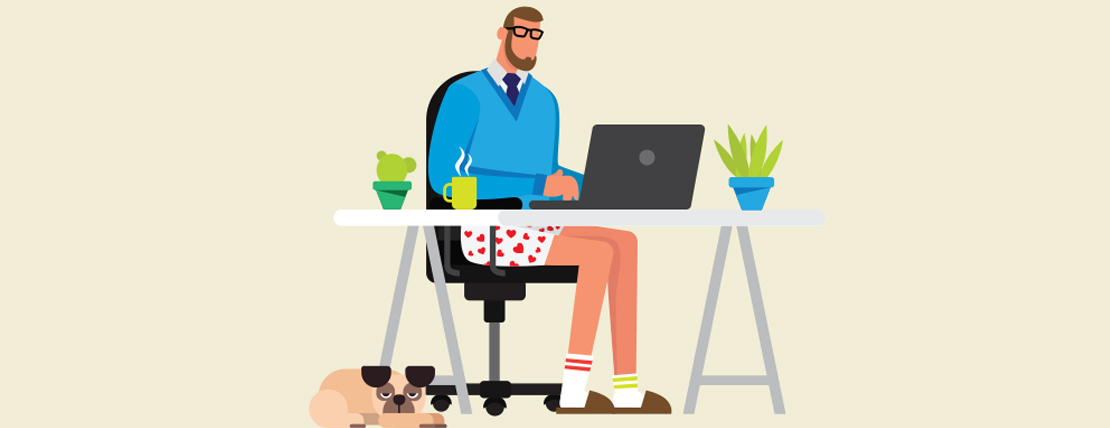I’m still pretty new to WorldatWork. My first official day was Aug. 3, 2020.
The hiring process — from application to formal offer — unfolded over the month of July, with the coronavirus pandemic in full swing.
Naturally, this meant that the interview process was strictly virtual, consisting of separate Zoom conversations with five future colleagues.
I wore a T-shirt and shorts for each of those interviews. Before joining WorldatWork (in a 100% remote position), I had worked remotely on a full-time basis for roughly three years. In that time, a T-shirt and shorts combo — hoodie and sweatpants once the weather turns cold here in the Philadelphia suburbs — has been my go-to work attire.
I don’t have a Zoom shirt. And it never occurred to me — during any of those interviews or in any other virtual meeting I’ve attended before or since — that I might be underdressed for a work occasion. Especially since the corona- virus sent almost everyone else home from the office, and “COVID casual” has become a thing.
Apparently, there are others giving more thought to dress codes in the age of COVID, and to how the pandemic figures to affect how employees dress for work going forward.
“I don’t have a Zoom shirt. And it never occurred to me — during any of those interviews or in any other virtual meeting I’ve attended before or since — that I might be underdressed for a work occasion. Especially since the coronavirus sent almost everyone else home from the office, and ‘COVID casual’ has become a thing.”
Coupon Follow, for example, recently conducted a survey of 1,038 employees working remotely since the coronavirus arrived in the U.S. in February 2020. The survey saw more than half of these workers (52%) saying that, while working from home in the midst of COVID-19, they still had to abide by a dress code that was instituted before the pandemic.
Moreover, 30% of those employees working for a company with a “business professional” dress code said they still have to wear that attire while working remotely.
Not everyone has the same style mandate while working at home, of course. A quarter of female respondents said they most commonly work in loungewear, with 20% of men typically going with athletic wear during the workday.
And, in case you’re wondering, another portion of employees are choosing attire even more casual than their gym clothes. Sixteen percent of respondents indicated that they’ve worked in their pajamas during the pandemic. Another 29% said they have opted to go au naturel while working from home. That’s right, naked. (Hopefully, these employees don’t have a lot of video calls on the days they decide to just not get dressed at all.)
The survey also analyzed the connection between at-home dress codes and productivity levels. Among those dressing more formally during the pandemic, nearly 80% said they felt productive throughout the day. Seventy percent of those wearing gym clothes and 50% of those in their PJs said the same.
It’s worth pointing out that the company conducting this survey, Coupon Follow, is a real-time coupon code search engine and directory designed to help consumers save money on things like, say, new clothes for work. So, make what you will of these results.
But, whatever these particular findings say to you, it’s still tough to determine whether there’s a correlation between clotheshorses and workhorses.
For example, there are studies suggesting more formal work outfits equate to better performance on the job, while others find that employees who dress down are more productive and perceived more positively by colleagues. These mixed results beg the question: Do dress codes really matter anymore, and will they matter when more workers eventually return to an office environment?
Maybe not, according to respondents to Coupon Follow’s survey. Just a third of the employees polled said they feel like dress codes are really necessary.
Ultimately, many organizations will likely find that the clothes workers wear have no bearing on their ability to do their work and do it well, said Dave Ulrich, a professor of business at the University of Michigan’s Ross School of Business.
“There is a dangerous pattern in most measurement issues,” said Ulrich, who is also co-founder of the RBL Group. “We measure what is easy more than what is right. For example, we measure number of hours of training or we measure the number of levels of management, rather than the impact of the training or the impact of management structure on outcomes that matter.”
Likewise, what employees wear to work is easy to observe and track, Ulrich added.
“But, generally, how one dresses is not related to how one thinks, acts and feels. The goal of any work — wherever it is — is to engage in activities that create value for customers. Without creating value in the marketplace, there is not a workplace. Most customers focus less on dress than on products and services that matter to them.”







